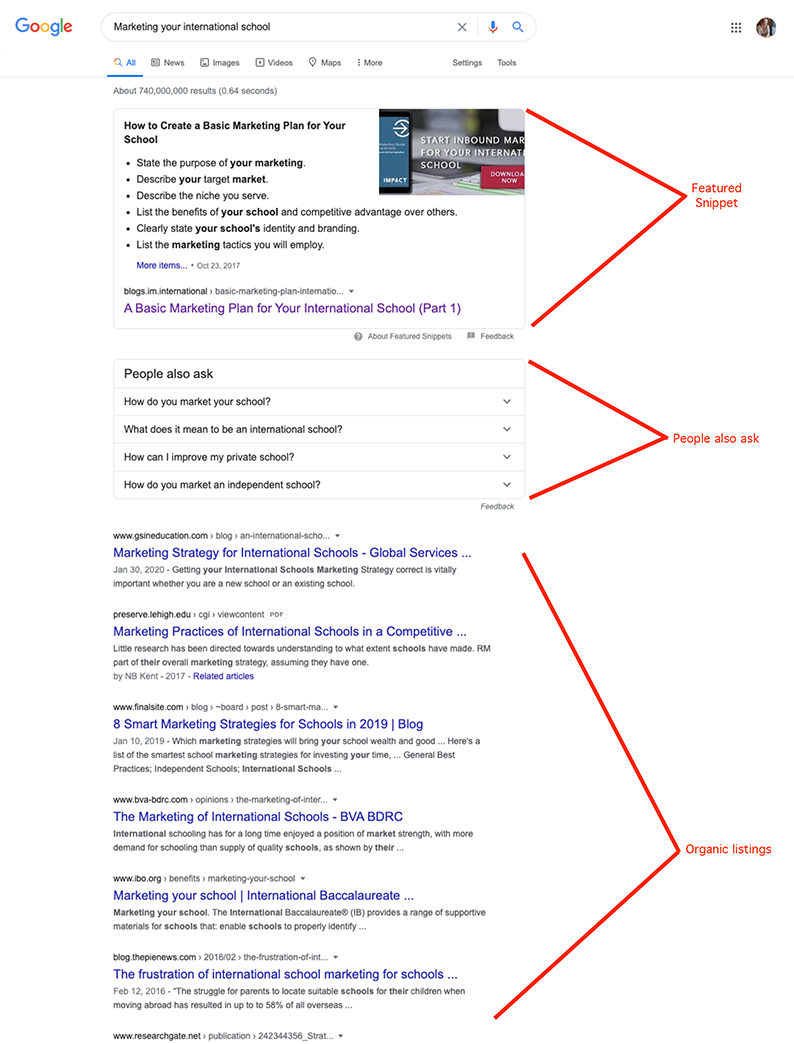Blogging should be a critical part of the content strategy for your school, however, your posts won’t help increase admissions inquiries unless anyone actually reads them! Your school’s blog posts should be optimized so search engines like Google and Bing give it high authority and serve it up as a result to a search query from a family.
Knowing and implementing the basics of this type of optimization, known as Search Engine Optimization (or SEO for short), is important when creating blog posts.
This is the first of a two-article set of items to keep in mind when creating new blog posts.
The Basics of Optimized Blog Posts for Schools
Let’s consider that you want to create an article about a recent science fair your school, which is located in Seoul, produced. Employing the following five tactics will increase the optimization of your blog post.
1) Use Long-Tail Keywords That Families Will Search For
The goal is to have your school’s blog post to be returned in response to a search query that a family types into a search engine. Regardless of how many words this query is, it is referred to as a keyword in SEO terminology.
When optimizing blog posts for your school, it’s generally a good idea to select a longer, more detailed keyword. These are commonly referred to as long-tail keywords. For example, we would want the article on the recent science fair to be found if a family searches for “Which schools in Seoul have science fairs?”
It’s important to note that you do not need to use this exact keyword word-for-word. Search engines are smart and are able to pull results from the content in your blog. If the post contains the words in the long-tail keyword throughout the content, it’s more likely to be given higher authority.
2) Use Your Keyword in Strategic Locations
Once you’ve decided on a keyword, be sure to use variations of it in several important parts of your post. These are:
- Webpage title
- Article title
- URL
- The actual blog article
- The meta-description for the webpage.
To use the keyword in the URL for your page, use hyphens for spaces and as much of the keyword as possible. For example, we might choose the following URL for our post: http://www.yourschool.com/science-fair-seoul-school-oct-2016/. The date is optional, but might be good to use to avoid address clashes with the 2017 fair.
The meta-description for the webpage is a sentence or two that is only read by the search engine and not by the families visiting your site.
3) Use Your Keyword Throughout Your Article
It’s important to use the keyword in the main body of your article. However, don’t go overboard and use it too many times – write for humans and not for search bots.
Search engines discourage this practice, known as keyword stuffing, and may actually penalize you if you use the keyword too often! Optimize the blog posts for your school by making your keyword about 1-2% of the body text.
4) Keep Your Blog Articles Short
Generally, people would prefer to read several short articles on the web than one long one. Search engines know this and will rank shorter articles more highly.
Shoot for articles about 300-700 words long. If you have content that is considerably longer than this, consider creating a video or eBook instead. One important reason for making shorter articles is that more and more families are using mobile devices to do their research. Long articles are difficult to read on such devices and search engines reward webpages that are mobile-optimized to be easy to consume on portable devices.
5) Use Short Paragraphs and Short Sentences
In keeping with making your blog posts easy to read, use shorter sentences when possible and smaller paragraphs. Each paragraph should have only one main idea. If your paragraph is several lines long, consider breaking it into multiple paragraphs.
To check for ease of readability, you can use a variety of online tools to calculate measures like the Flesch Reading Ease score. The easier your text is to read, the better the user experience.
There’s More…
We’ll cover another five techniques on how to optimize blog posts for your school in part 2 of this series. Until then, make sure to use these tips in each blog post you put on your school’s site.
To learn more about developing a content strategy for your school, download our free ebook, Inbound Marketing for International Schools today.






SUBMIT YOUR COMMENT